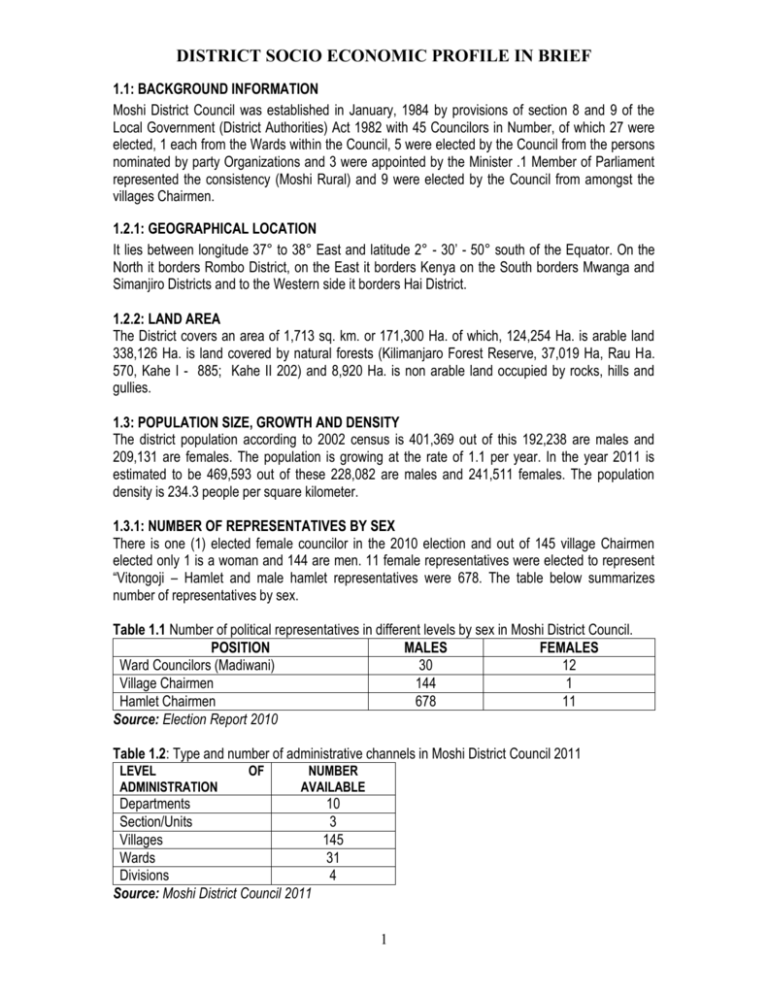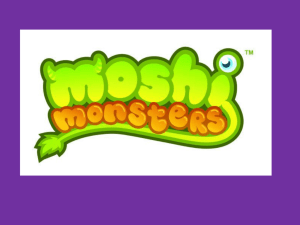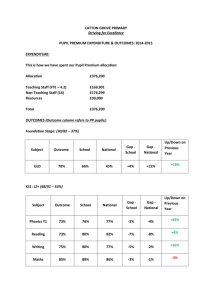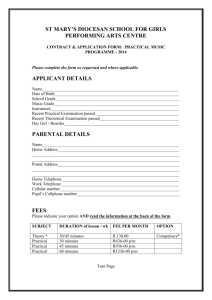1 - Kilimanjaro
advertisement

DISTRICT SOCIO ECONOMIC PROFILE IN BRIEF 1.1: BACKGROUND INFORMATION Moshi District Council was established in January, 1984 by provisions of section 8 and 9 of the Local Government (District Authorities) Act 1982 with 45 Councilors in Number, of which 27 were elected, 1 each from the Wards within the Council, 5 were elected by the Council from the persons nominated by party Organizations and 3 were appointed by the Minister .1 Member of Parliament represented the consistency (Moshi Rural) and 9 were elected by the Council from amongst the villages Chairmen. 1.2.1: GEOGRAPHICAL LOCATION It lies between longitude 37° to 38° East and latitude 2° - 30’ - 50° south of the Equator. On the North it borders Rombo District, on the East it borders Kenya on the South borders Mwanga and Simanjiro Districts and to the Western side it borders Hai District. 1.2.2: LAND AREA The District covers an area of 1,713 sq. km. or 171,300 Ha. of which, 124,254 Ha. is arable land 338,126 Ha. is land covered by natural forests (Kilimanjaro Forest Reserve, 37,019 Ha, Rau Ha. 570, Kahe I - 885; Kahe II 202) and 8,920 Ha. is non arable land occupied by rocks, hills and gullies. 1.3: POPULATION SIZE, GROWTH AND DENSITY The district population according to 2002 census is 401,369 out of this 192,238 are males and 209,131 are females. The population is growing at the rate of 1.1 per year. In the year 2011 is estimated to be 469,593 out of these 228,082 are males and 241,511 females. The population density is 234.3 people per square kilometer. 1.3.1: NUMBER OF REPRESENTATIVES BY SEX There is one (1) elected female councilor in the 2010 election and out of 145 village Chairmen elected only 1 is a woman and 144 are men. 11 female representatives were elected to represent “Vitongoji – Hamlet and male hamlet representatives were 678. The table below summarizes number of representatives by sex. Table 1.1 Number of political representatives in different levels by sex in Moshi District Council. POSITION MALES FEMALES Ward Councilors (Madiwani) 30 12 Village Chairmen 144 1 Hamlet Chairmen 678 11 Source: Election Report 2010 Table 1.2: Type and number of administrative channels in Moshi District Council 2011 LEVEL ADMINISTRATION OF NUMBER AVAILABLE Departments 10 Section/Units 3 Villages 145 Wards 31 Divisions 4 Source: Moshi District Council 2011 1 Below population are summarized in the table sex, for all Ages as per projections Table 1.3: Total population by sex and Age group in Moshi Rural (Projections for 2010) Age Both Saxes TOTAL Male Female Total 462,087 224,009 238,078 0 -14 166,207 83,892 82,315 15 - 64 266,342 126,692 139,650 65+ 29,538 13,424 16,114 Source: National Bureau of Statistics, 2006 Vol. xii 1.3.1: DISABILITY INFORMATION Table 1.4 below shows type of disability by sex according to 2002 National census, it shows that there were 56% of more males with disability in Moshi District Council female who made up 44% of disabled. Leprosy/Physically hand capped category effected more persons while the albino category was the least in the district. Table 1.4: Shows type of disability by sex TYPE OF DISABILITY Total NUMBER Male Leprosy/Physicals Hand 2051 1184 capped Visual in Impaired 362 189 Dumb/Hearing Impaired 634 328 Albino 107 57 Mentally Hand caped 1,756 998 Multiple Hand caped 1,165 650 Total 6,075 3,406 Percent 100 56.07 Source: National Population Census 2002 2 Female Total TOTAL PERCENT Male Female 867 33.76 34.76 32.8 173 306 50 758 515 2,669 43.93 5.96 10.44 1.76 28.91 19.4 100 5.55 9.63 1.67 29.30 19.08 100 6.4 11.46 1.87 28.40 19.30 100 DISTRICT SOCIO ECONOMIC PROFILE IN BRIEF ADMINSTRATION UNITS AND POPULATION CHARACTERISTICS The district is divided into 4 divisions, 31 wards, and 145 villages after striking 7 villages which were within TPC Estate and 689 hamlets. Table 1.5 below shows population characteristics;TABLE 1.5: POPULATION CHARACTERISTICS TYPE OF POPULATION Total Population 401,369 Males 192,238 Females 209,131 Sex Ratio 92 Intercensal Growth Rate (5) 1.1 Total age Dependency Ratio 49.5 Male 105 Female 92 Percent of Age Group 0-14 Total 42 Male 44 Female 41 Percent of Age Group 15-64 Total 50 Males 49 Females 52 Percent of age Group 65+ Total 7.5 Male 7.3 Female 7.8 Percent of Population with Disability 1.50 Age at first marriage (in years) 28 Male 28 Females 24 Widowhood (%) Male Females Child Orphans (%) Male Females CHARACTERISTICS Literacy Rate Male Female Net Enrolment Rate Males Females Employment in Business Operations Employment in Office Work Employment in Agriculture Employment in Livestock keeping Employment in Fishing Employment in elementary Occupation Employment in Plant Operations/Assemblies Average Household Size (Persons per Household) Cement baked bricks as Main Building Materials used for Walls. Cement as main building Materials Used for floor (5) Corrugated iron sheets tiles as Main Building Materials used for Roofing Electricity as main source of Energy for lighting Firewood charcoal as main Source of energy for Cooking Piped protected well spring as Main Source of Drinking Water Tradition pit latrines as main type of toilet facility Percent with No Toilet Facility Hand Hoe as asset Owned by Most People Average No. of person per sleeping room 60 20 96 1.13 1.06 1.21 Source: National Population Census 2002 3 % 85 87 83 93 922 93 12 5.21 73 0.85 1.11 6.85 1.21 45 33 43 92 12 98 75 94 2.14 52 0.41 1.4: ETHNICITY The Chagga and the Pare make up the two main ethnic groups in the district. The Chagga live mostly in the mountain areas and the Pare occupies part of the lowlands. The small groups are Wakahe and the Wakwavi who are also residing in the lower zones. Further more the Chagga and the Pare are sub-divided into different dialects and clans such as Wamachame who speaks Kimachame and the Wagweno who speaks Kigweno etc.However, socially there is little separation between the two main groups. Inter marriages are quite common. 1.5: EARLY CONTACT WITH THE EUROPEANS The district contact with the Europeans can be traced back as 1840.In 1848 the Germans, Rebman and Kraft visited the area and were the first Europeans to see Mount Kilimanjaro. This history of early contact with European missionaries gave the region a start in the establishment of education and health services over much of the rest of Tanzania. ECOLOGICAL SYSTEM 1.6: PHYSICAL FEATURES The district is characterized by mountainous topography on the northern part which forms the Kilimanjaro Mountain, while moving towards the south are the lowland. 1.6.1: RAINFALL PATTERN Rainfall pattern is highly dependent on altitude. The district in some years enjoy two rain seasons one being between October to December while the normal rain season is from March to June. The Lowlands receive an average of 600 mm, the central part 1100 mm and the High lands 1,600 mm. 1.6.2: TEMPERATURE The district has an average daily temperature of 26º C. The highest temperatures occur in the months of February, March, April, September October and November during which the mean maximum temperatures are around 31º while the mean minimum temperatures are in June, July, December and January when the temperatures go down to about 15ºC. 1.7: AGRO ECOLOGICAL ZONES The district has 3 agro ecological zones as follows;ZONE (i) Lower Zone(Lowland) (ii) Middle/Central Zone (iii) Upper Zone (Highland) ALTITUDE METERS 700 - 900 901 – 1500 RAINFALL MM 400 - 800 900 – 1400 1501 – 5895 1401 – 2000 MAJOR CROPS GROWN IN THE AREA Paddy, maize sugar cane by irrigation Maize, bananas, beans, diary Cattle keeping Coffee, Bananas, maize, Avocados, beans, Natural forest. Source: Moshi District Council 2008 1.7.1: THE LOWER ZONE (LOWLANDS) The zone with the altitude ranging from 700 – 900 meters above sea level where people are engaged in paddy production by irrigation, maize and open cattle grazing. The area is sparsely populated with population ranging between 15 – 30 people per square kilometer as compared to other areas. As for instance in the highlands where the population per square kilometer is even higher that the district average (ranges between 400 – 800 people per sq. km) which is an indicator of land shortage. 4 DISTRICT SOCIO ECONOMIC PROFILE IN BRIEF 1.7.2: THE MIDDLE/ CENTRAL ZONE Zone with the altitude ranging from 901 – 1500 meters above sea level where people are engaged in agriculture, the main crops are coffee, maize, beans, fruits and diary cattle keeping at zero grazing system. This is less populated as compared to the highlands. 1.7.3: THE UPPER ZONE (HIGHLANDS) The zone is located in the slope of Mt. Kilimanjaro and most densely populated area with the altitude ranging from 1501 – 5895 meters above the sea level. People in this zone are engaged in agriculture. The main crops are coffee, banana, fruits and diary cattle. 2.0: ROAD NETWORK Moshi District Council has a total of 640.7 kilometers of road network out of these; 240 kilometers are district roads while 400km are minor (feeder) roads. About 240 km are at gravel level, which are passable throughout the year. 400 km of the roads are clay soils most of which are not passable during rain season. Almost 80% of Moshi roads are mountainous terrain with volcanic clay. 3.0: ECONOMIC POTENTIALS The land currently under cultivation is 108,389 Hectares or 87.2% of the total arable land (124,254). About 68,718 households engaged full in agriculture. Agriculture is the major economic activity of the district. 3.1 DISTRICT OPPORTUNITIES 3.1.1 Land is the highly dependant asset, 98% of total population in the district depend on it families own land under customary Law. 3.1.2 Springs and permanent rivers The district has over 300 traditional Irrigation furrows, streams and rivers that favour irrigation pontentiality 3.1.3 Mt. Kilimanjaro – The world natural heritage is the biggest World Tourist attraction. 3.1.4 NGO’s and CBO’s in the district are the major stakeholder to the community social and economic development. Amount to more than 60 in number working in different villages within the district, covering mainly social services support to the communities 3.1.5 Availability of social services – schools, health facilities, good roads network, electricity to 80% of the total population are accessible 3.2 THREATS/CHALLENGES 3.2.1 Land shortage has led to high population density of 234.3 people per square kilometers. 3.2.2 Decreasing coffee production by small holder farmers has led to low household Income. However efforts are made through ASDP and other agricultural related programs for reviving coffee production. 3.2.3 Environmental destruction – Tree cutting, water sources destruction, poor agricultural practice are rampant. However, environment and tree planting campaign are underway throughout the district with the focus of the most affected areas. 5 4.0: ESSENTIAL STATISTICS 4.1: AGRICULTURE Agriculture is the major economic activity in the district. 4.1.1: FOOD AND CASH CROP PRODUCTION The major food crops are: Maize Rice Bananas 4.1.1.1: FOOD CROPS Table 4.1: Major food crops produced in the district are bananas, maize and rice. Production for 2010/2011 was as follows:Crop Bananas Maize Rice Target Ha. 26,900 32,400 4,770 Production Exp. Tone 403,500 113,400 33,960 Ha. Cultivated 26,900 30,538 4,720 Tone Harvested 332,000 28,448 25,028 Source: Moshi District Council 2011 Production of food crops highly depend on rainfall, irrigation and use of agricultural inputs Fertilizers seeds and agrochemicals 4.1.1.2 CASH CROPS Coffee Cotton 4.1.2: COFFEE Coffee was introduced in the district in year 1898 in Kilema Mission. Currently the crop is cultivated in twelve Regions in the country. In Moshi district it cultivated in upper and middle zones Area under small holder cultivation is 34,324 hectares production of which has been fluctuating for the past eleven years as shown below:Coffee production trends from 2000/2001 to 2010/2011 (In tones) YEAR Area in Ha. PRODUCTION IN TONES 2000/2001 4,051 2001/2002 2,262 2002/2003 1,900 2003/2004 2,100 2004/2005 1,905 2005/2006 34,340 931 2006/2007 19,729 1,608 2007/2008 19,729 1,763 2008/2009 19,729 3,171 2009/2010 20,882 2,221 2010/2011 18,779 1,154 Source: Moshi District Council 2011 6 DISTRICT SOCIO ECONOMIC PROFILE IN BRIEF Fall on production has been activated by the following factors: Old age of coffee trees, 50% of the total small holder hostage is having tress with age above fifty years. High price of inputs Poor management in the rural cooperative societies – misuse of moneys and other capital goods has demoralized member farmers. Lack of marketing strategies 4.1.2.1: REVIVAL OF COFFEE PRODUCTION The District initiated the Coffee rehabilitation Programme in 1998. Since then up 2000-2011 a total of 1,159,250 new coffee Seedlings were distributed to small holder farmers covering 1,065.14 ha. Seedling distribution since 2000 to 2011 YEAR 2000/2001 2001/2002 2002/2003 2003/2004 2004/2005 2005/2006 2006/2007 2008/2009 2009/2010 2010/2011 SEEDLING 118,200 22,200 31,400 14,200 1,6050 15,500 65,000 23,930 22,942 32,440 Source: Moshi District Council 2011 Estate coffee production The district had a total of 5,727.39 Ha. Under estate coffee production. Only 3,331.7 Ha. have been let to private investors as summarized bellow;PRIVATE INVESTORS IN COFFEE PRODUCTION Ha. Available 1054 310 201 204 247 365 137 154 319 432 399 252 399.59 138 NAME OF INVESTOR Ha. Invested Mufindi Tea Company The Trading Company Theo Trading Company Block and Bocha Ltd. Blue mountain coffee Farm Ltd. Granite care (T) Ltd. Dhiru Chauhan Ms. Vaso Agro venture Tchibo Estate Tchibo Estate Tchibo Estate Tchibo Estate Tchibo Estate 188 171 164 207 325 120 117 259 3031.5 84.4 112 322.8 138 7 561 310.8 244 5727.39 Tchibo Estate Tchibo Estate Tchibo Estate 390 286 146 3331.7 Source: Moshi District Council 2011 N.B Currently it is difficult to get production figures from these estates. 4.1.3 COTTON PRODUCTION Cotton is the main cash crop in the lower zone. Production of this crop has not been expanding due to uncertainty of market. Table 4.3: Below are production figures in the area mainly Moshi District YEARS HA. CULTIVATED 2000/2001 2001/2002 2002/2003 2003/2004 2004/2005 2005/2006 2006/2007 2007/2008 2008/2009 2009/2010 2010/2011 TONE HARVESTED 10.1 10.45 14 50 45 50 3 10 10 10 10 4.054 5.933 5 5.2 6 50 3.0 2 1 0 0 Source: Moshi District Council 2011 4.2: LIVESTOCK DEVELOPMENT Livestock is second to agriculture in providing food and income to the people of Moshi district. The council is endowed with a variety of livestock which are found in every corner of the district. With the three agro ecological zones, livestock keeping in the district is of two styles: Zero grazing which is practiced in the high and middle zone Free ranching is practiced in the Lower zone LIVESTOCK POPULATION No LIVESTOCK TYPE 1. 2. 3. 4. 5. 6. 7. 8. 9. Dairy Cattle Beef Cattle Sheep Pigs Milk Goats Goat (Meat) Horse Dog Donkey NUMBER 78,470 84,312 37,088 48,108 6,144 140,593 17 26,712 967 8 DISTRICT SOCIO ECONOMIC PROFILE IN BRIEF Source: Moshi District Council, 2011 CHICKEN S/N CHICKEN TYPE NUMBER Layers 40,000 1. Broilers 185,700 2. Indigenous 799,604 3. Ducks 25,050 4. Source: Moshi District Council, 2011 The Government is currently the sole provider of extension services through farmer groups. As for livestock services both the Government and the private sector provide them to farmers. Livestock services currently available in the district include the following;No. Type of Services available Cattle Dips 1. Livestock 2. development centers Artificial Insemination 3. centers Slaughter house 4. Slaughters slabs 5. Milk collection centers 6. Hide bandas 7. Livestock input outlets 8. Source: Moshi District Council, 2011 Total Working 10 8 14 14 24 24 3 250 3 2 38 3 250 3 2 38 NGO’s, CBO’s and FBO’s also play an invaluable role in promoting the livestock sector. These organizations provide improved livestock to farmers by improving the genetic potential of livestock and also enhancing the income of the people. NGO’s which are working in the district include KEDA, MACDA, HPT, ST VICENT DE POUL, ELCT and EOTF. 5.0 EDUCATION OVER VIEW The district has a major role of providing pre-primary education, primary education and secondary education. The table below shows an over-view of education facilities available in the district. 9 Table 5.1: Education facilities in the year 2011 S/N SECTOR GOVERNMENT PRIVATE TOTAL 232 252 59 3 1 1 6 14 36 238 266 95 3 1 17 3 4 1 Pre-primary school 2 Primary school 3 Secondary school 4 TTC 5 Folk development college 6 VETA 7 Other institutes 8. Universities Source: Moshi District Council 2011 17 3 3 5.1 AIMS AND OBJECTIVES OF EDUCATION IN THE DISTRICT The Tanzanian education policy of 1995 emphases that ″ pre –school and primary education is fundamental to the strengthening of higher levels of education, laying strong foundations in scientific and technological, literacy and capacity and thus a means of self reliant personal and national development”. In view of this emphasis, the education department in the district has the following intentions:1. To prepare every child in the district for pre primary school education, primary education and where possible for secondary education. It is at these level religious organizations, individual people and parents are encouraged to build pre primary, primary and secondary schools. 2. To reduce the drop-out rate from 2.33% (1999) to about 0.1% (year 2011) by establishing programs to improve learning and teaching environment so as to retain the pupils in schools up to standard seven level. 3. To reduce the illiteracy rate of 2.4% (1998) by introducing the community based Adult education and Reflect approach (MUKEJA) to all adults in all 31 wards. 4. To promote the girls/boys ratio in education in the primary and secondary levels to be 1:1 5. To conduct seminars/trainings to school committee members hence to empower them with skills of administration and management. 6. To increase the number of pupils who passes PSLE to join secondary school education 7. To promote teacher/staff guidance and discipline, staff appraisal and giving them more skills to manage school funds. 8. To undertake the MEMKWA programs to all 31 wards. 9. To provide learning opportunities to all disabled children 5.1.2 PRE - PRIMARY EDUCATION 5.1.2.1 PRE – PRIMARY SCHOOLS The pre-primary education is for children aged between 5 – 6 which is formalized and systemized in the school Curriculum Package. It is where the children develop the communication skills and other learning programmed activities. It is a formal preparatory system to primary school. The medium of instruction is Kiswahili in Government schools and English in the English medium schools which are privately owned. 10 DISTRICT SOCIO ECONOMIC PROFILE IN BRIEF The table below shows the number of classes and the number of children in Government schools and private school from the year 2000 to 2011. Table 5.2: Enrolment of pre - primary schools YEAR NO OF SCHOOLS 2000 2001 2002 2003 2004 2005 2006 2007 12 12 14 15 27 242 242 181 GOVERNMENT ENROLEMENT BOYS GIRLS TOTAL 1,248 1,361 2,291 2,191 2,297 3,147 49,546 3,646 NO OF CLASES PRIVATE ENROLMENT BOYS GIRLS TOTAL 1,216 1,329 547 1,340 2,383 3,191 48,457 3,412 2,464 2,690 2,838 3,531 4,680 6,338 98,003 7,058 2 2 2 3 3 3 3 6 42 35 54 44 40 55 535 113 41 38 43 40 39 50 532 104 83 73 97 93 79 105 1,067 217 2008 181 3030 5601 2009 232 4,713 4,600 2010 232 4,609 4,434 2011 232 4,672 3,447 Source: Moshi District Council 2011 8631 9,313 9,043 8,119 7 9 12 14 152 939 1,106 1,361 54 909 1,011 1,232 206 1,848 2,117 2,593 The problem of the Government pre –primary schools is that they are being taught with grade B/C teachers while the education and training policy insists grade A teachers; to teach in such schools, few classes are being taught with grade A teachers trained. 5.1.2.2 PRIMARY SCHOOLS This is a seven years Education course after pre-primary school. It is compulsory in enrollment and attendance to all school age going children. The entrance registration age is 7 years old. The table below shows the GER of standard I and of the standard I-VII for Government and private primary schools from the year 2000 – 2011. (Sources of data TSM 1 & 2) Table 5.3A: Government primary school enrolment in the district by 2011 YEAR NUMBER GER FOR STD I GER OF STD I – VII OF BOYS GIRLS TOTAL BOYS GIRLS TOTAL SCHOOL 2000 193 6923 2001 193 6863 2002 194 11682 2003 194 9732 2004 199 7493 2005 242 6391 2006 245 5987 2007 249 6052 2008 251 6030 2009 252 5,856 2010 252 5,790 2011 252 5,638 Source: Moshi District Council 2011 6749 6707 10585 8844 7098 6073 5837 5986 5908 5817 5485 5309 13672 13570 22167 18576 14591 12484 11,824 12,038 11,938 11,673 11,275 10,947 11 38888 40536 46422 49980 50149 50236 49,546 47,909 46,668 43457 40,624 38,526 39519 40597 45899 48619 49825 49237 48,457 47,007 45,807 42,805 39,703 37,591 78407 81133 92321 98599 99974 99473 98,003 94,916 92,475 86,262 80,327 76,477 Table 5.3B: Private primary school enrolment in the district by 2011 YEAR NUMBER GER FOR STD I OF BOYS GIRLS TOTAL SCHOOL 2000 2 48 58 106 2001 2 55 59 114 2002 2 53 61 114 2003 3 49 56 105 2004 3 58 60 118 2005 3 65 64 129 2006 3 52 42 94 2007 6 108 104 212 2008 7 137 146 283 2009 9 83 121 204 2010 12 204 180 384 2011 14 206 198 404 BOYS 207 209 274 382 417 425 535 812 952 939 1,106 1,361 GER OF STD I – VII GIRLS TOTAL 260 242 262 373 385 394 532 760 868 909 1,011 1,232 467 451 536 755 802 819 1067 1572 1,820 1,848 2,117 2,593 Source: Moshi District Council 2011 The objectives of enrolment in Government primary schools have not yet been met up to now because of; Poverty to few of the families in the district due to drought. Low income of some of the marginalized societies. Bad behavior of some members of the community e.g. excessive drinking, laziness and negligence. Truancy of pupils due to orphanage, petty business and few in a child labor in the district due to orphaned situation. Negative attitude towards education of some few parents. Table 5.4 below shows the enrolment compare with drop outs from the years 2000 to 2011. YEAR ENROLMENT DROP OUTS PARCETAGE OF DROUP BOYS GIRLS TOTAL BOYS GIRLS TOTAL OUTS 2000 28888 39519 78407 979 810 1789 2.33 2001 40536 40597 81133 825 666 1491 1.90 2002 46422 45899 92321 468 386 854 1.05 2003 49980 48619 98599 451 360 811 0.87 2004 50149 49825 99974 423 347 770 0.78 2005 50236 49237 99473 329 254 583 0.58 2006 49,546 48,457 98,003 340 298 638 0.64 2007 47,909 47,007 94,916 164 140 304 0.32 2008 46,668 45,807 92,475 146 113 259 0.28 2009 43,457 42,805 86,262 2010 40,624 39,703 80,327 2011 38,526 37,951 76,477 Source: Moshi District Council 2011 The problem which arises here is that a big number of pupils who are enrolled in standard one do not complete the cycle of primary education. More efforts are made to all parents to participate in 12 DISTRICT SOCIO ECONOMIC PROFILE IN BRIEF the whole school programmed in collaboration with school committees ward executive. District Education Officials and village leaders are trying their level best to arrest the problem. 5.2 SCHOOL INFRASTRUCTURE Many schools in the district have shortages of classrooms, latrines teachers quarters, desks, tables, chairs and cupboards, and others are old; hence this situation leads to poor facilititation and respience of skill and knowledge of pupils. This is one of the causal factors in the sub-standard of education in the district. The table below shows the school infrastructures from the year 2005 – 2010. (From TSM 1X2 Data). 13 In the above table the district has planned strategies to minimize the problem in the collaboration with the Central Government, community and other Donors (external and Internal) 1. In trying to reduce the magnitude of problem of the teachers’ quarters, the district has planned to build 50 staff quarters each year until 2014. 2. In trying to mobilize the community to make enough desks, tables, chair cupboards. The district has planned to make 1000 desks 50 tables, 25 chairs 50 cup-boards each years until by year 2010. 3. To construct/build 50 classrooms each year with replacement of the old buildings until by the year 2010. 4. To renovate 30 classrooms each year by using development funds until by the year 2014 5.5 THE DISABLED CHILDREN This is a group of disabled children such as blind, the deaf, the crippled and the mentally retarded. There is quite a big number of retarded such pupils at home places but parents do not bring them for registration in schools because of lack of established school/centers of such pupils in the district. Few of established day schools for these children are;1. Mwasi Kusini primary school for the deaf dump 2. Msufini and Mabogini primary schools for the mental retarded. 14 DISTRICT SOCIO ECONOMIC PROFILE IN BRIEF Table 5.6 shows the total number of disabled in the district from the year 2005 – 2010 GROUP OF 2005 2006 2007 B0YS BLIND 5 GIRLS 1 T0TAL 6 BOYS 4 GIRLS 6 TOTAL 10 BOYS 8 GIRLS 8 TOTAL 16 2008 BOYS 1 GIRLS 1 2009 TOTAL 2 DEAF 21 15 36 9 12 21 5 6 11 44 49 93 MENTAL RETAEDED 94 69 163 129 95 224 94 79 173 119 86 205 DUMP 12 9 21 5 9 14 6 2 8 44 49 93 CRIPPLED 29 28 57 8 3 11 140 119 259 18 9 27 15 Source: Moshi District Council 20011 8 23 7 9 16 11 10 12 ALBINO 61 42 103 15 2010 BOYS GIRLS TOTAL BOYS GIRLS TOTAL 0 2 2 1 7 8 26 23 49 97 83 180 64 38 102 8 5 13 The major problems facing the establishment of more schools are:1) Lack of area (land) to start the school 2) Lack of teaching/learning materials facilities for both pupils and teachers. 3) Insufficient sources of fund for construction. 4) Poor support from the community in contributing for construction of such schools In order to overcome the problem the district has constructed a resource center for disabled at Njia Panda Primary school since 2006, it is now in place with children studying. 5.6 TEACHERS – PUBLIC SCHOOLS Teachers requirement 2,877 Teachers available 2,733 Short fall 144 Availability of essential buildings and furniture Tables below shows BUILDING – PUBLIC SCHOOLS Classrooms Teachers Houses 2,388 2,532 Need 2,020 229 Available 368 2,203 Short Fall Source: Moshi District Council 2011 Pit Latrine Office 4,482 2572 1258 490 348 142 Store 490 209 281 FURNITURE Desks Need 43,090 Available 40,270 Shortfall 2,820 Source: Moshi District Council 2011 Tables 4,659 2,896 1,763 chairs 5,647 3,764 1,883 Cupboard 3,353 2,084 1,269 5.7 STANDARD SEVEN EXAMINATION PERFORMANCE YEAR 2010 Pupils who set for standard seven examination 12,197 (Males-6,006; Females -6,191) Pupils who passed standard seven examination Pupils selected to join form 1 in public school =7,491 (Males 3,505 &Females 3,986)= 81% 16 7,491 =61.4% DISTRICT SOCIO ECONOMIC PROFILE IN BRIEF 5.8 SECONDARY EDUCATION Public secondary schools Institutional/Private Sec. schools TOTAL 59 36 95 NUMBER OF STUDENTS AS OF NOV. 2011 SCHOOL/INSTITUTION GIRLS Public 13,644 Inst./Private 5,926 Total 19,570 Source: Moshi District Council 2011 NUMBER OF TEACHERS SCHOOL/INSTITUTION REQUIRED Public 1,179 Inst./Private Total Source: Moshi District Council 2011 BOYS 11,715 5,541 17,256 AVAILABLE 894 SECONDARY SCHOOL INFRASTRUCTURES No. Type Required Available 1. Classrooms 897 644 2. Staff qrts 1,179 146 3. Toilet pits 1,170 952 4. Laboratories 180 29 5. Desks 25,759 23,191 6. Office tables 1,179 814 7. Library 60 12 8. Office chairs 1,179 814 Source: Moshi District Council, 2011 6.0: HEALTH 6.1 DEMOGRAPHIC DATA Women of child bearing age are 84,954 Children under 1 year are 16,548 Children under 5 years are 82,740 Population growth rate 1.1 % Crude Birth rate 1/1000 Crude death rate 0.6/1000 Infant mortality rate 21/1000 Under five mortality rate 0/1,000 Life expectancy (49 years male) 52 years female 17 TOTAL 25,759 11,467 37,226 SHOTFALL 285 Shortfall 253 1,033 218 151 2,568 365 48 365 6.2 ENDEMIC DISEASES Malaria Rabid animal bite Dysentery Typhoid Cholera Table 6.1: The main top ten diseases caused Mortality & Morbidity for the year 2010 DISEASES CASES DISEASES CASES Pneumonia 44 ARI 78,478 Malaria 28 Malaria 60,206 Hypertension 13 Pneumonia 35,161 Other diagnosis 10 Intestinal 20,534 worm Tuberculosis 6 Diarrhoer 16,023 ARI 5 Skin infection 10,036 Peptic ulcers 3 UTI 9,093 Burns 3 Eye Infection 7,791 Diabetic Mellitus 2 Cardiovascular 7,703 diseases Anaemia 1 Other infection 4,162 Source: Epidemiological data – Mtuha from 66 health facilities Table 6.3: Health facilities (A) HOSPITALS District Designated Hospitals Institutional hospitals Private hospitals Total (B) RURAL HEALTH CENTERS Council RH.C Private Total (C) DISPENSARIES Council dispensaries Religious Institutions Private Dispensaries Total Source: Moshi District Council 2011 No 2 3 1 6 7 1 8 32 24 16 72 18 DISTRICT SOCIO ECONOMIC PROFILE IN BRIEF ESSENTIAL INDICATORS INDICATOR DISTRICT Infant Mortality Rate 5/1000 Under 5 Mortality Rate 1/100,000 Maternal Mortality Rate 54/100,000 Fertility rate 18% Source: Moshi District Council 2010 MEDICAL STAFF TITTLE NEED MDS 9 AMOS 20 CO 168 NURSES 308 PHARMACY TECH. 5 PHARMACY ASSIST. 8 LAB. TECH 5 HEALTH OFFICERS 8 RADIOGRAPHER 4 PHYSIOTHERAPIST 4 DENTAL OFFICER 5 MEDICAL RECORDER 4 Source: Moshi District Council 2010 RATIOS RATIOS Number of people per doctor Number of people per Hospitals Number of people per RHC Number of People per Dispensary. Source: Moshi District Council 2010 NATIONAL 62/1000 191/1000 257/100,000 22% IN SERVICE 5 13 88 204 1 5 2 5 1 1 3 0 DISTRICT 1:200,685 1:100,342 1:80,274 1:4,836 SHORTFALL 4 7 80 104 4 3 3 3 3 3 2 4 NATIONAL 1:450,000 1:250,000 1: 50,000 1: 10,000 7.0: WATER SERVICES Moshi District has all rivers and springs originating from Mt. Kilimanjaro. These are the major sources of water gravity system in the district. Unfortunately 98% almost of all sources have been destroyed. This has led to low water volume in rivers and springs. Population accessible to piped Water 325,460 which is 70% Gravity water systems 36 Shallow wells 30 Bore holes 3 19 The district has signed an agreement since April, 2007 with a German Organization KfW which is almost completing (90%)the Kirua Kahe water Project, upon completion new sources and distribution networks to supply water to 74% of the population will be accessible. 8.0: INDUSTRY Currently only one factory is available in the district. This is the sugarcane processing owned by TPC. However there are numerous small scale industries basically such as oils seed processors as well as timber, maize milling, tin smith, black smiths and food preservation. 9.0: ECONOMIC INFRASTUCTURE The road network linking the district with its neighbors is relatively good, giving the district in comparable access within and outside the country. 10: COOPERATIVES SOCIETIES No. Types of Cooperatives 1. Rural Co-Operative Societies 2. Saving & Credit Co-Operative Societies 3. Joint Venture societies 4. Milling/Mining Co-Operative societies 5. Irrigation Co-Operative Societies 6. Transport Co-Operative Societies 7. Consumer Co-Operative Societies 8. Other Service Co-operative Societies Total 41 48 2 3 3 1 5 4 11: COMMUNICATION NETWORKS Many parts of the district are served with a land line (TTCL), Mobile phone services are available is some parts of the district especially in sub urban centers. Vodacom, Zantel, tiGO and Celtel are the companies which provide services in the districts. Radio Services include FM stereo, Sauti ya Injili heard in almost all parts of the district. E-Mail and Internet services are provided by private entrepreneurs especially in Sub-Towns. 12: TOURISM Moshi district is endowed with one of the world’s wonders, Mt. Kilimanjaro (the highest mountain in Africa – 5, 895 M. above sea level). Other Tourist areas include Kilimanjaro National Parks and Rau Forest. There are numerous tourist hotels including Kilema Kyaro, Babylon Lodge, Marangu Hotel, Kibo Hotel and Capricorn etc. 13: INVESTMENT The district is encouraging both local and foreign Investors in all sectors of the economy. 20 DISTRICT SOCIO ECONOMIC PROFILE IN BRIEF 13.1 AREA FOR INVESTMENT 13.1.1Crop Production Intensification of crop production through improved husbandry Irrigated horticultural crop production Provision of Irrigation infrastructure works Commercial fodder production Provision of private extension services to crop producers Production of hybrid (HB) seed e.g. HB Coffee seedlings Provision of market outlets 13.1.2 Livestock production Intensification of livestock production through improved husbandry Poultry and eggs production Pig production Provision of veterinary services, Including cattle dip spraying services Milk production and processing Development of animal traction Milk collection center 13.1.3 Environmental Sector Environmental information dissemination and networking Supply of seedlings and other planting material Provision of training in biodiversity management 13.1.4 Tourism Sector Development of cultural tourism centers Establishment of eco-tourism, agro-tourism and nature trails Provision of improved tourist services including high quality hotels, curio shops, trained tour guides, reliable transport and communication services. 13.1.5 Agro-based Industries Fruit juice and wine Processing Vegetable processing Grain mills Edible oil manufacturing using maize, sunflower etc Food processing – potato crisps, cornflakes etc. avocado/carrot soap/lotion 13.1.6 Roads, Transport and Communication Services Hiring/leasing of road construction and maintenance equipment Transport services provision to production areas and tourist attractions. Provision of mobile phones and internet services Provision of public media, Including Television, radio and newspapers Provision of marketing information 13.1.7 Energy Sector Provision of solar products and services Provision of biogas products and services 21 Provision of electricity Provision of energy saving stoves 13.1.8 Education sector Establishing and expanding schools facilities in districts to offer higher quality services Construction of hostel facilities particularly for secondary students. Establishing technical training institutions Provision of Primary education materials Provision of sports/recreation facilities e.g. stadium gymnasium 13.1.9 Health Establishing new and expanding existing health facilities in the districts for higher quality services adequate Provision of medical equipment Provision of adequate essential drugs Provision of sanitation service in urban centers and in smaller towns. 13.1.10 Financial Service Sector Provision of banking services Provision of insurance services Provision of micro financing services 13.1.11 Water Rehabilitation/extension of existing water schemes Construction of new water supply project to the population not accessibly to piped water Institution set up. 22








